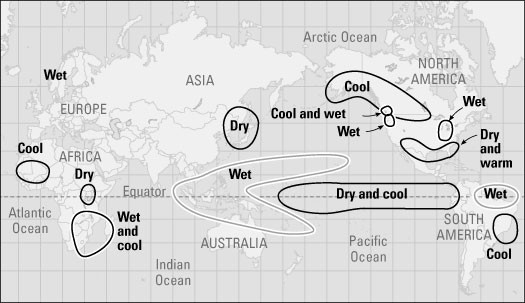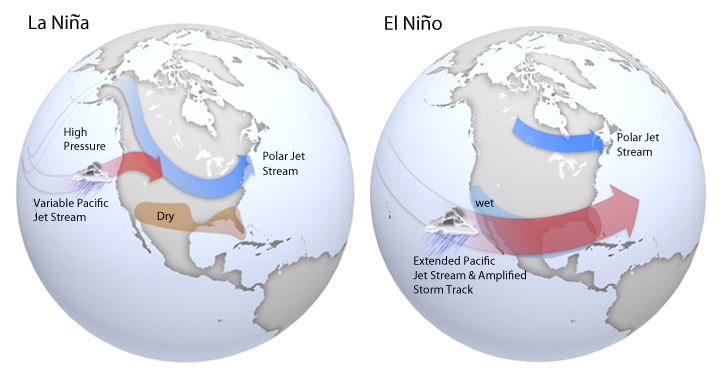Cartoon about El Niño or La Niña
A great question I was asked in my previous introduction to El Nico post prompted me to do a little research into La Niña, the cooling extreme phase of the El Niño Southern Oscillation.
Here is a quick post to demonstrate the reasons why climatologists, economists, scientists and anyone else, seem to talk less about La Niña than El Niño.
1) El Niño and El Niño Southern Oscillation are commonly used interchangeably.
I mentioned this in my last post and I believe this is because the name El Niño comes from the observations of fishermen who supposedly named this phenomenon when they observed unusually warm waters in the Pacific Ocean. Therefore, the entire oscillation focuses around the extreme warming phase more so than the cooling phase of La Niña. However, nowadays you can sometimes see the entire phenomenon known simply as the "Southern Oscillation".
2) La Niña occurs less often than El Niño
Although both warm and cold phases occur on average every 3 to 5 years, the interval between events varies from 2 to 7 years. The NOAA report that, since 1975, La Niñas have been only half as frequent as El Niños. However, recent research suggests that the frequency of La Niña could nearly double from the historic record of approximately once every 23 years, to once every 13 years. The cause of this is from the "increased frequency of extreme El Niño events, which are conducive to development of the extreme La Niña events" as La Niña tends to follow El Niño, as the system swings from one extreme to the other.
3) La Niña is arguably less dangerous than El Niño
Roger Pielke Jr. and Christopher Landsea found a significant relationship between the ENSO cycle and US hurricane losses, with La Niña showing higher damages than El Niño. However, aside from this damage, the main argument that La Niña is less dangerous than El Niño is that it displays "typical" weather conditions (e.g. wet where it should be, cold where it should be) but intensified.
Here are the common winter weather patterns of La Nina:

In general, during La Niña, the easterly trade winds strengthen and cold upwelling along the equator and the West coast of South America intensifies, leading to lower sea surface temperatures in the equatorial Pacific region. This is caused by a "buildup of cooler-than-normal subsurface waters in the tropical Pacific". Both La Niña and El Niño tend to peak during the Northern Hemisphere winter.
Therefore, depending on where in the world you are, La Niña may be a welcome sight. For example, La Niña can cause the Pacific jet stream to be more variable over the US, and often moves more north than usual, leading to more storms and higher snowfall in the Northwest region of the US, and fewer storms and reduced snowfall in the southern US region. El Niño has the opposite effect, with more storms over the southern US due to a stronger Pacific jet stream and drier northern US.

The familiarity of conditions under La Niña, compared to El Niño, which flips everything on its head, may be why there is less of an emphasis on La Niña's dangerous effects.
However, that's not to say there are none. La Niña is less predictable than El Niño due to its effect on jet streams and storm tracks, and this can cause huge problems for industries such as agriculture and tourism. In addition, the intensity of La Niña can wreak havoc even if the conditions are typical, such as extreme dryness in the southern US and western South America leading to droughts, as well as extreme rainfall in Australia and Indonesia leading to flooding.
Another interesting idea is that La Niña usually follows El Niño, meaning it can undo some of the damages. For example, droughts in countries such as India due to El Niño, could be followed in the next year by higher than normal rainfall, which can offset the problems caused. In my opinion, however, I don't believe that these two extremes can counteract each other. The climate becoming more and more extreme will only lead to extreme changes and force humans to find solutions to problems that are constantly changing. Droughts followed by floods do not necessarily mean the population in the affected areas can survive, and these extremities could easily render many parts of Earth uninhabitable.
Conclusion
I'd like to quickly conclude that I don't believe we should focus more on El Niño than on La Niña. Both phenomena can cause real and significant impacts on a global scale. Luckily, I have noticed an increase in news headlines regarding La Niña, particularly as speculation of 2016 being a La Niña year, following the El Niño year of 2015. It's important that we continue to investigate the impacts of both El Niño and La Niña in the future, and to improve prediction methods to mitigate against damages and losses from them.
Particularly as we continue to change the global climate, it may be more difficult to predict and understand the El Niño Southern Oscillation, and as the World Meteorological Organisation (WMO) secretary general, Michel Jarraud puts it "this naturally occurring El Niño event and human-induced climate change may interact and modify each other in ways which we have never before experienced".
Edit (Dec 23):
An interesting article in The Wall Street Journal today emphasises what this blog post is about, which is to not underestimate La Niña as the effects could greatly impact one of the most volatile markets in the world: agriculture. To summarise, if 2016 is a La Niña year, food prices will likely be pushed up due to droughts in the US, Canada and Brazil. I was also interested to find out that La Niña has followed El Niño 11 times out of the last 15! Have a read if you're interested!
Here are the common winter weather patterns of La Nina:

In general, during La Niña, the easterly trade winds strengthen and cold upwelling along the equator and the West coast of South America intensifies, leading to lower sea surface temperatures in the equatorial Pacific region. This is caused by a "buildup of cooler-than-normal subsurface waters in the tropical Pacific". Both La Niña and El Niño tend to peak during the Northern Hemisphere winter.
Therefore, depending on where in the world you are, La Niña may be a welcome sight. For example, La Niña can cause the Pacific jet stream to be more variable over the US, and often moves more north than usual, leading to more storms and higher snowfall in the Northwest region of the US, and fewer storms and reduced snowfall in the southern US region. El Niño has the opposite effect, with more storms over the southern US due to a stronger Pacific jet stream and drier northern US.

The familiarity of conditions under La Niña, compared to El Niño, which flips everything on its head, may be why there is less of an emphasis on La Niña's dangerous effects.
However, that's not to say there are none. La Niña is less predictable than El Niño due to its effect on jet streams and storm tracks, and this can cause huge problems for industries such as agriculture and tourism. In addition, the intensity of La Niña can wreak havoc even if the conditions are typical, such as extreme dryness in the southern US and western South America leading to droughts, as well as extreme rainfall in Australia and Indonesia leading to flooding.
Another interesting idea is that La Niña usually follows El Niño, meaning it can undo some of the damages. For example, droughts in countries such as India due to El Niño, could be followed in the next year by higher than normal rainfall, which can offset the problems caused. In my opinion, however, I don't believe that these two extremes can counteract each other. The climate becoming more and more extreme will only lead to extreme changes and force humans to find solutions to problems that are constantly changing. Droughts followed by floods do not necessarily mean the population in the affected areas can survive, and these extremities could easily render many parts of Earth uninhabitable.
Conclusion
I'd like to quickly conclude that I don't believe we should focus more on El Niño than on La Niña. Both phenomena can cause real and significant impacts on a global scale. Luckily, I have noticed an increase in news headlines regarding La Niña, particularly as speculation of 2016 being a La Niña year, following the El Niño year of 2015. It's important that we continue to investigate the impacts of both El Niño and La Niña in the future, and to improve prediction methods to mitigate against damages and losses from them.
Particularly as we continue to change the global climate, it may be more difficult to predict and understand the El Niño Southern Oscillation, and as the World Meteorological Organisation (WMO) secretary general, Michel Jarraud puts it "this naturally occurring El Niño event and human-induced climate change may interact and modify each other in ways which we have never before experienced".
Edit (Dec 23):
An interesting article in The Wall Street Journal today emphasises what this blog post is about, which is to not underestimate La Niña as the effects could greatly impact one of the most volatile markets in the world: agriculture. To summarise, if 2016 is a La Niña year, food prices will likely be pushed up due to droughts in the US, Canada and Brazil. I was also interested to find out that La Niña has followed El Niño 11 times out of the last 15! Have a read if you're interested!

